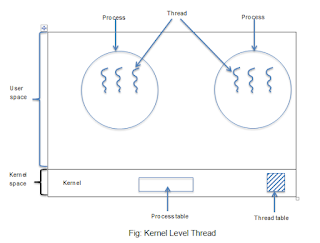Process vs. Thread:
|
Parameter |
Process |
Thread |
|
Sharing of memory and address space |
It can't
share same memory area i.e. address space. |
Threads can
share memory and files. |
|
Time for creation |
It takes more
time to create a process. |
It takes less
time to create a thread. |
|
Time for termination |
Requires more
time to complete the execution and termination of process |
Less time for termination. |
|
Execution speed |
Execution is very
slow. |
Execution is a very
fast. |
|
Time for switching |
Requires more
time to switch between two processes. |
Requires less
time to switch between two threads. |
|
Communication |
Implementing communication between processes is bit more difficult. |
Communication between two threads is very easy to implement because
threads share the same memory. |
|
System calls |
Required to communicate with each other. |
System calls are not required. |
|
Coupling |
Process is loosely
coupled. |
Threads are tightly
coupled. |
|
Resource requirement |
It requires more
resources to execute. |
Requires fewer
resources, hence, called as lightweight process. |
|
Parallelism |
Processes are not
suitable for parallel activities. |
Suitable for parallel activities. |
Thread Functionalities:
Thread synchronization:
All threads within a process share the memory and files. If one
thread is trying to modify one record in a file, it will affect with another
threads. Hence, there is a need of mechanism for synchronizing the activities
of thread.
User level and Kernel level threads:
There are two main
ways to implement threads:
1. In user space and;
2. In the kernel.
1. User Level Threads:
These types of threads are loaded entirely in a user space;
the kernel knows nothing about them. When Threads are managed in user’s space,
each process needs its own private thread
table. A thread table consists of the information of program counter, stack
pointer, registers, state, etc. The
thread table is managed by runtime system. When a thread is moved to ready
state or blocked state, the information needed to restart it is stored in the
thread table.
Advantages:
·
They
allow each process to have its own scheduling algorithm.
·
Entire
process is loaded in user space, so the process does not switch to the kernel
mode to do thread management. This saves the overhead of two mode switches.
·
They
can run on any operating system.
Disadvantages:
·
When
a user level thread executes a system call, not only the particular thread gets
blocked but, all of the threads within the process are blocked.
·
In
user level threads, only a single thread within a process can execute at a
time. So, multiprocessing cannot be implemented.
2. Kernel Level Threads:
In kernel level threads, the kernel does total work of thread movement. There is no thread table in each process. The kernel has a thread table that keeps track of all the threads in system. When a thread wants to create a new thread or destroy any existing thread, it makes a kernel call, which takes the action.
The kernel’s thread table holds each thread registers, state
and their information. The information is saved as with user level threads, but
it is now in the kernel instead of the user space.
Advantages:
·
The
kernel can simultaneously schedule a multiple threads from the same process on
multiple processors. This means it supports multiprocessing whereas, user level
threads can't support this.
·
If
a thread in a process is blocked; the kernel can schedule another thread of the
same process.
·
The
kernel routine themselves can be multithreaded.
·
Scheduling
by kernel is done on a thread bus.
Disadvantages:
·
More
cost for creating and destroying threads in the kernel.
·
Transfer
of control from one thread to another within the same process requires a mode
switch to the kernel.
If we combine both approaches then we get the advantages of
both. Some operating systems provide this type of facility. In combined system,
thread creation is done completely in user space. Best example for this
approach is Sun Solaris.


No comments:
Post a Comment